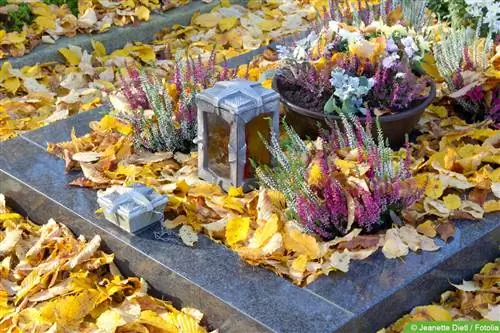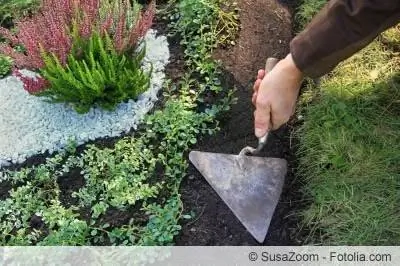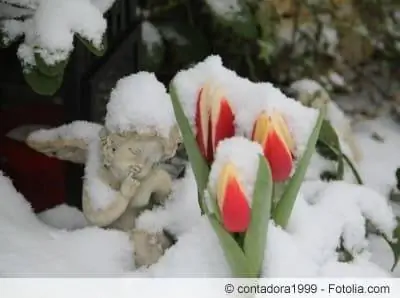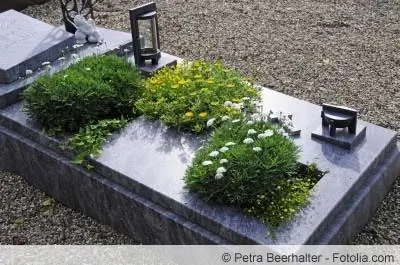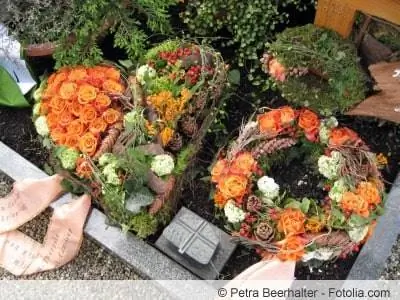- Author admin [email protected].
- Public 2023-12-17 03:39.
- Last modified 2025-01-24 12:45.
The grave design over autumn and winter can be easily implemented with the right plants. These 15 tips will help you implement grave planting in a creative way.
Colorful planting: 4 tips
Colors are an important aspect of grave planting. Flowering plants in autumn and winter are much rarer, but there are some that you can use specifically for grave planting. They evoke certain emotions, which are clearly enhanced when combined with evergreen plants or other decorations. The following 4 tips go into more detail about the colorful facets of the autumn and winter grave:
Blooming autumn grave planting
From mid-September to the end of November is the time for plants that only show their flowers late in the year. The variety of plants is particularly impressive due to the different colors, ranging from white to pink to violet. Ideally, plant the species so that their flowering period overlaps with that of the winter bloomers. This means there are no gaps. You can also integrate evergreen or leafy plants. The following list gives you an overview of the suitable flowering plants for your grave planting:
- Bergenia 'Autumn Blossom' (Bergenia cordifolia 'Autumn Blossom')
- Bushy autumn aster (Aster dumosus)
- Garden pansies (Viola wittrockiana)
- Daisies (Bellis perennis)
- Autumn cyclamen (Cyclamen hederifolium)
- Autumn Anemone (Anemone hupehensis)
- Autumn Chrysanthemums (Chrysanthemum Indicum Hybrids)
- Autumn gentian (Gentiana sino-ornata)
- Horn violet (Viola cornuta)
Flowering winter grave design
If you want to present flowering accents on the grave throughout the second half of the year, you should include plants in the grave planting that bloom during the winter. There is a small selection of plants that can be planted on graves without any problems and can even withstand snow:
- Christmas roses (Helleborus niger)
- Small periwinkle (Vinca minor)
- Small winter aconite (Eranthis hyemalis)
- Lenzenrose (Helleborus orientalis)
- Snowdrop (Galanthus)
- Transylvanian liverwort (Hepatica transsilvanica)
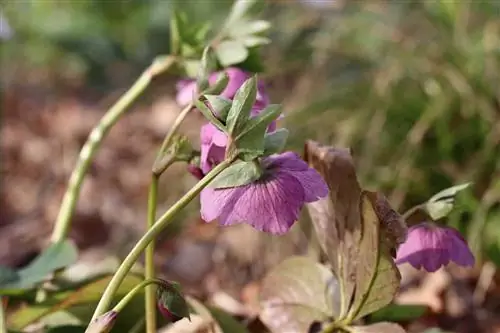
Colorful berries
If you don't like the flowering plants mentioned, you can instead choose plants whose berries don't fall off over the winter. Berries provide a completely different accent that can be integrated into the grave design in an interesting way. Plants such as the red carpet berry (Gaultheria procumbens) or the cotoneaster variety 'Streibs Findling' (Cotoneaster microphyllus 'Streibs Findling') present intensely red berries decorated with evergreen leaves throughout the entire winter and autumn period. This means they are a little less noticeable than flowers and are therefore an interesting alternative for decorating the grave.
Use foliage plants
In addition to flowers and berries, ornamental leaf plants are welcome. The focus of these plants is on the unique leaf coloring, which does not disappear during the colder half of the year. In this way, you can combine evergreens with plants whose foliage is colored red or yellow or even patterned, for example. You can even replace flowers completely, as their color intensity immediately catches the eye. Patterns in particular can be created excellently with these plants if they are planted densely enough. Due to their growth characteristics, you should take a look at the following foliage plants:
- Spotted deadnettle (Lamium maculatum)
- Purple bells (Heuchera)
- Silverleaf (Senecio cineraria)
Grave design: 6 structure tips
While the flowering and colorful elements contribute an important part to the grave design, you must not forget the structural plants. They are plants that serve a specific purpose in the grave and for this reason should not be forgotten.6 tips on the topic to follow:
Use border plants
Use plants over the fall or winter to surround the grave. This gives them a natural look that can be creatively designed using different leaf colors and growth forms. Especially with snow, the border plants look a little melancholic. The following are ideal for this:
- Broom heather (Calluna vulgaris)
- True lavender (Lavandula angustifolia)
- Houseleeks (Sempervivum)
- Snow heather (Erica carnea)
- White Stonecrop (Sedum album)
Set evergreen accents
You can never go wrong with evergreen plants during the dark seasons. They provide a splash of color, even when there is a lot of snow falling. Due to their growth habit, tolerance to cutting and leaf color, you can use the following species for this:
- Boxwood (Buxus sempervirens)
- Ivy (Hedera helix)
- Japanese spindle bush (Euonymus japonicus)
- Small rhododendrons like Rhododendron impeditum
- Mühlenbeckie (Muehlenbeckia axillaris)
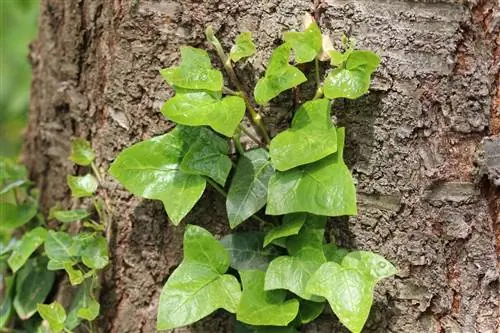
Don’t forget ground cover
Ground cover plants, along with evergreen plants, are a classic for autumn and winter grave design. They are low-growing, form closed areas and are usually hardy. Use ground cover as a canvas for the rest of the decor you incorporate. The following species are particularly popular as grave plants:
- Japanese Ysander (Pachysandra terminalis)
- Creeping Gunsel (Ajuga reptans)
- Sand thyme (Thymus serpyllum)
- Prickly nut (Acaena)
- Carpet golden strawberry (Waldsteinia ternata)
potted plants
Some plants have beautiful foliage or attractive flowers, but are not hardy. Since they are only suitable for grave planting in the fall, use planters to store them safely before winter. Fortunately, the plants can be planted in decorative containers. This way you don't have to dig up these plants before winter:
- Barberry 'Lutin Rouge' (Berberis thunbergii 'Lutin Rouge')
- Japanese lavender heather (Pieris japonica)
- Laurel (Laurus nobilis)
- Summer Spiraea 'Bullata' (Spiraea japonica 'Bullata')
- Grape heather 'Little Flames' (Leucothoe fontanesiana 'Little Flames')
Trees and bushes
A small tree or dwarf shrub is ideal if you want to protect the grave from snow over the winter or if you don't want excessive planting. The plants take up a central point in the grave design, which is determined by the growth habit and the foliage. Some trees create an almost tragic look that is perfect for winter. Other species provide hope with their dense growth and evergreen foliage. Of course, you should only use trees or bushes that do not grow too quickly so that the grave is not displaced by the tree. Ask the cemetery administration beforehand whether trees can be planted. If not, you will have to switch to container specimens. The following species and varieties are well suited:
- Blue dwarf juniper 'Blue Star' (Juniperus squamata 'Blue Star')
- Blue cushion cypress 'Minima Glauca' (Chamaecyparis lawsoniana 'Minima Glauca')
- European holly (Ilex aquifolium)
- Cushion spruce 'Little Gem' (Picea abies 'Little Gem')
- Cuddly tree of life 'Teddy' (Thuja occidentalis 'Teddy')
- Dwarf hemlock 'Nana' (Tsuga canadensis 'Nana')
Note:
A big advantage of evergreen grave trees is the ability to use them all year round. If you prefer a permanent grave design, you should use shrubs and small trees (if permitted).
Alternative: grasses
Grasses should not be underestimated for modern graves. If you choose hardy ornamental grasses, you can enjoy the plants throughout the entire autumn and winter period. The grasses are particularly attractive when it has snowed and snow adorns the stalks. The following species are particularly suitable during the cold season:
- Blue fescue (Festuca cinerea)
- Japanese sedge (Carex morrowii)
- Calmus (Acorus calamus)
5 decoration tips
Of course, decoration is part of grave design. You can incorporate decorations to better emphasize the feeling over the cooler half of the year. The following 5 tips will help you design winter and autumn graves:
Shapes
What is meant by shapes? Place the plants in attractive shapes to visually enhance the grave. For example, you can plant small flowering plants in wavy lines in a sea of evergreen plants. Use triangles filled with different foliage plants to create a color gradient. Add a path of gravel or bark mulch framed with ground cover or small trees to highlight the headstone.

Candles and lights
Connect the plants together with candles or lights to give the grave a cozy look. Especially in the dark winter months, light sources can be perfectly combined with grave plants to commemorate the deceased. Candles and lights can also be creatively integrated into the design. For example, you can place a lantern at one of the lower corners of the grave while the dimmer light highlights the evergreens in the background. Candles, on the other hand, can be placed in the middle or directly in front of the gravestone to draw the focus to them. Let your imagination run wild when combining light sources and plants.
Natural materials
With natural materials, the decoration can be personalized even more. Many elements found in nature can be used in grave design to emphasize an emotion or to support structure. The selection is large and can be used as a decorative accent if desired:
- dried cut plants
- gravel
- Stones
- Pinecones
- Decorative pumpkins in autumn
- branches
- Rosehips
Decorative items
While plant materials are one of the most popular options for decorating the grave over the winter, you don't have to do without classic decorative items. These include, for example, figures, bowls or boards with sayings. Include these elements in the grave planting to commemorate the deceased.
Use grave covering
If you prefer grave planting only over summer and spring, you can cover the grave with plant materials over the cold season. The grave covering makes it possible to completely avoid planting over autumn and winter. Of course, you can incorporate individual plants and classic decorations such as lights, candles, figures or panels into the covering to adapt it even more to your taste.
The following materials are particularly popular for covering graves in the cooler half of the year:
- Blue fir branches
- Douglas fir branches
- Yew branches with berries
- Moss such as reindeer moss or star moss
- Nordmann fir branches
- Juniper branches with berries
- Cypress branches
Note:
If you are offered branches of blue spruce instead of blue fir, there is no need to worry. The species Picea pungens is known and available under both names.

